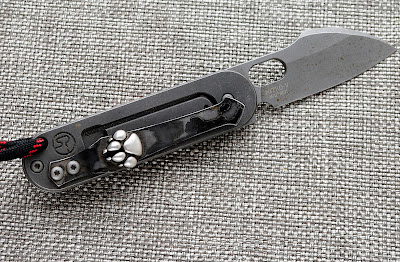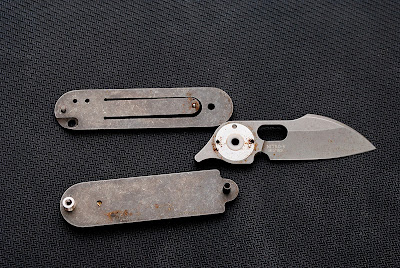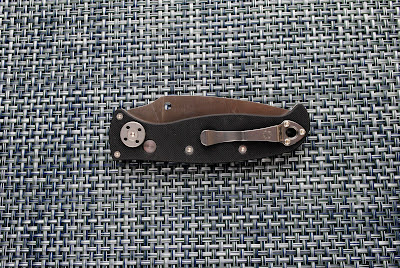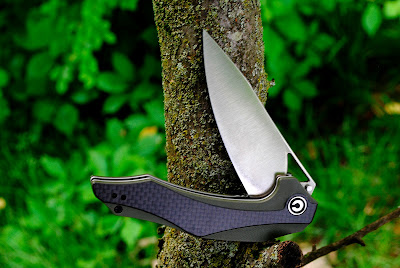I recently bought another club knife from the National Knife Collectors Association. It's the 1984 knife made by Hen and Rooster. As some of you may remember, I'm not a big fan of club knives. https://knifesearch.blogspot.com/2023/03/not-huge-fan-of-club-knives.html.
There are
exceptions, based on looks and style. The 1984 NKCA is one of them. The knife
is very nice and in excellent condition, and I like the non-symmetric bolsters
that sandwich the jigged brown bone. The NCKA medallion is very striking. All
of which made me want to reach for my wallet.
 |
| Hen and Rooster 1984 NKCA knife of the year |
According to
the 12th edition of 'Collector Knives' by Price, the 1984 NKCA club knife was
made by Bertram, USA. The sequentially numbered knives, limited to 7000, came
with jigged bone handles and cost $38. In 2025 dollars that’s about $119. In
1998, Price claimed it had a collector value of around $125.
 |
| I think the medallion is a classy addition |
However, the
true value is only what someone will pay for it. eBay shows two sold for an
average of $65. Buyer beware. Other similar knives with a different medallion
embedded on the handle were also seen. They weren't selling.
The
interesting part is the history of the manufacturer.
Sometime in
1845, Carl Bertram started the Hen & Rooster brand. Carl was already an
established and well-known owner of a poultry business in Solingen, Germany.
Being nobody's fool, Carl capitalized on his reputation by creating the Hen
& Rooster logo to mark his brand in about 1865. They were considered
well-made, high-quality knives. The firm was handed down within the family and
maintained the quality.
 |
| The tag line almost falls off the blade |
The original
firm also manufactured contract knives with Hen & Rooster on one side of
the blade tang, and numerous other names on the reverse side. During the late
1960s and early 1970s Bertram made knives for Carter Cutlery, Carter, Jeffrey,
Kane, Voss, John-I-Son, Ky-Col, Gutmann Cutlery, Fife Cutlery, Mar-cal, A.G.
Russell, L & N Loan Co., and Field & Co.
In 1975, A.G.
Russell purchased the firm. A.G.’s company operated the Bertram Hen &
Rooster manufacturing facility and brand for five years. During this time, he
produced Hen & Rooster knives as well as other knives bearing his own
trademark. At some point, A.G. made knives for other companies with one side of
the tang stamped with the Hen & Rooster logo and the contract’s firm name
on the reverse side.
In 1980, the
factory in Solingen, Germany, closed.
 |
| The Hen and Rooster Logo with Bertram Cutlery |
This is
curious. The 1983 NKCA knife bears the Hen & Rooster tang stamp, and the
reverse tang stamp reads Rostfrie Solingen Germany. But if the plant was
closed….?
 |
| Reverse tang reads Rostfrie Solingen Germany |
There are
several possibilities. My information could be wrong. It has been collected
from several internet sources, and errors may occur. The blade could be new old
stock, purposed for the NKCA knife. And while the factory was closed, it may
have continued to operate to meet legal obligations.
In 1983, the
Hen & Rooster trademark and the Bertram name were acquired by three
individuals: James Frost of Frost Cutlery, Howard Rabin of Star Sales, and Hugo
Schiesen of Robert Klaas, from Solingen, Germany. Robert Klaas may have been
the creator of my Hen and Rooster. My original assumption was that the knife
was made at the Bertram plant in Solingen, but it could have been made at
another plant in the area.
After a short
period of time, James Frost bought the sole rights to the trademark and
distribution of all Hen & Rooster knives in the United States. In general,
the Hen and Roosters manufactured before 1980 are thought to be of the best
quality.
My knife is
numbered 4092 of the 7000 made. The pivot is a bit tight, I suspect a drop of
oil is overdue. The handle is lined with brass, and the lock mechanism is
simply known as a back lock, made famous by the Buck 110 Hunter. The
interesting thing, like some Italian autos, the spring is composed of two
leafs. I suspect they are not replaceable. The bolsters are nickel silver, a
cunning alloy which doesn't contain any silver. The brown bone grips are nicely
jigged.
 |
| Double leaf spring |
The blade
steel is a little more problematic. It's listed simply as stainless steel. What
stainless steels were available in 1980? There were a few, including 440C, the
best of the 440 series, which was common, as were AUS-8, 425M, and S60V. I
suspect 440C was utilized. It's still a good, inexpensive steel used today. But
I suspect the NKCA year knives were never intended for use.
Collectors
always want to know, "Did I get a good deal?" Of course, you can't
really believe any of us about price. I'm happy with the knife, so, yes, I got
a good deal.


































